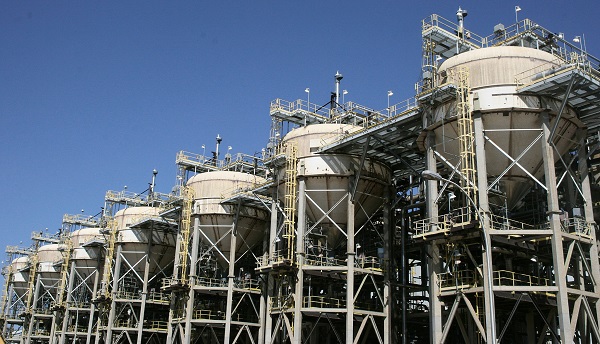Alberta
“It’s Canada’s Time to Shine” – CNRL’s $6.5 Billion Chevron Deal Extends Oil Sands Buying Spree

From Energy Now
Canadian Natural Resources Ltd.’s $6.5 billion acquisition from Chevron Corp. marks the latest in a string of deals that has helped make it the country’s largest oil producer and brought Alberta’s massive oil sands deposits almost entirely under local control.
CNRL has feasted on the oil sands assets of foreign energy producers over the past decade, snapping up stakes and operations from Devon Energy Corp. and Shell Plc as they shifted away from the higher-cost, higher-emissions oil sands business. Investors have applauded the strategy, which allows CNRL to boost output and make the operations more efficient.
That trend continued on Monday, with CNRL shares climbing more than 4% after the deal with Chevron raised its stake in a key oil sands mine and a connected upgrading facility, while also adding natural gas assets in the Duvernay formation.
“These assets build on the robustness of Canadian Natural’s assets,” said CNRL President Scott Stauth said on a conference call Monday. The deal boosts CNRL’s stake in the Athabasca oil sands project, which it first bought from Shell in 2017, to 90% from 70%.
The acquisition was largely expected and boosts CNRL’s oil and gas output by roughly 9%, adding the equivalent of 122,500 barrels of oil production per day.
“It’s just been a matter of time,” Eight Capital analyst Phil Skolnick said by phone, noting that CNRL had been seen as the logical buyer for Chevron’s oil sands business.
While CNRL also boosted its dividend by 7% on Monday, Desjardins analyst Chris MacCulloch cautioned the company’s additional debt to finance the acquisition “may disappoint some investors” given it plans to temporarily slow capital returns.
Still, MacCulloch said the deal is positive overall for CNRL as it further consolidates assets in the region. “There’s no place like home,” he wrote in a note.
Chevron, for its part, is the latest in a long line of US and international oil producers — such as BP Plc, TotalEnergies SE and Equinor ASA — that have shifted away from the oil sands after spending billions to build facilities in the heavy-oil formation. That has left the oil sands largely in the control of Canadian firms including CNRL, Suncor Energy Inc. and Cenovus Energy Inc.
“There’s no remaining, obvious assets available,” Ninepoint Partners partner and senior portfolio manager Eric Nuttall said after Monday’s deal. Ninepoint owns 3.1 million shares in CNRL, data compiled by Bloomberg show.
Many of those oil sands deals have been struck at prices that favor the Canadian buyers, which have consolidated land, reduced costs and boosted returns in recent years.
“It’s Canada’s time to shine,” Nuttall said, adding that he expects foreign investors will return to the country’s oil producers in the future.
Alberta
Red Deer Justice Centre Grand Opening: Building access to justice for Albertans

The new Red Deer Justice Centre will help Albertans resolve their legal matters faster.
Albertans deserve to have access to a fair, accessible and transparent justice system. Modernizing Alberta’s courthouse infrastructure will help make sure Alberta’s justice system runs efficiently and meets the needs of the province’s growing population.
Alberta’s government has invested $191 million to build the new Red Deer Justice Centre, increasing the number of courtrooms from eight to 12, allowing more cases to be heard at one time.
“Modern, accessible courthouses and streamlined services not only strengthen our justice
system – they build safer, stronger communities across the province. Investing in the new Red Deer Justice Centre is vital to helping our justice system operate more efficiently, and will give people in Red Deer and across central Alberta better access to justice.”

Government of Alberta and Judiciary representatives with special guests at the Red Deer Justice Centre plaque unveiling event April 22, 2025.
On March 3, all court services in Red Deer began operating out of the new justice centre. The new justice centre has 12 courtrooms fully built and equipped with video-conference equipment to allow witnesses to attend remotely if they cannot travel, and vulnerable witnesses to testify from outside the courtroom.
The new justice centre also has spaces for people taking alternative approaches to the traditional courtroom trial process, with the three new suites for judicial dispute resolution services, a specific suite for other dispute resolution services, such as family mediation and civil mediation, and a new Indigenous courtroom with dedicated venting for smudging purposes.
“We are very excited about this new courthouse for central Alberta. Investing in the places where people seek justice shows respect for the rights of all Albertans. The Red Deer Justice Centre fills a significant infrastructure need for this rapidly growing part of the province. It is also an important symbol of the rule of law, meaning that none of us are above the law, and there is an independent judiciary to decide disputes. This is essential for a healthy functioning democracy.”
“Public safety and access to justice go hand in hand. With this investment in the new Red Deer Justice Centre, Alberta’s government is ensuring that communities are safer, legal matters are resolved more efficiently and all Albertans get the support they need.”
“This state-of-the-art facility will serve the people of Red Deer and surrounding communities for generations. Our team at Infrastructure is incredibly proud of the work done to plan, design and build this project. I want to thank everyone, at all levels, who helped make this project a reality.”
Budget 2025 is meeting the challenge faced by Alberta with continued investments in education and health, lower taxes for families and a focus on the economy.

Quick facts
- The new Red Deer Justice Centre is 312,000 sq ft (29,000 m2). (The old courthouse is 98,780 sq ft (9,177 m2)).
- The approved project funding for the Red Deer Justice Centre is about $191 million.
Alberta
Made in Alberta! Province makes it easier to support local products with Buy Local program

Show your Alberta side. Buy Local. |
When the going gets tough, Albertans stick together. That’s why Alberta’s government is launching a new campaign to benefit hard-working Albertans.
Global uncertainty is threatening the livelihoods of hard-working Alberta farmers, ranchers, processors and their families. The ‘Buy Local’ campaign, recently launched by Alberta’s government, encourages consumers to eat, drink and buy local to show our unified support for the province’s agriculture and food industry.
The government’s ‘Buy Local’ campaign encourages consumers to buy products from Alberta’s hard-working farmers, ranchers and food processors that produce safe, nutritious food for Albertans, Canadians and the world.
“It’s time to let these hard-working Albertans know we have their back. Now, more than ever, we need to shop local and buy made-in-Alberta products. The next time you are grocery shopping or go out for dinner or a drink with your friends or family, support local to demonstrate your Alberta pride. We are pleased tariffs don’t impact the ag industry right now and will keep advocating for our ag industry.”
Alberta’s government supports consumer choice. We are providing tools to help folks easily identify Alberta- and Canadian-made foods and products. Choosing local products keeps Albertans’ hard-earned dollars in our province. Whether it is farm-fresh vegetables, potatoes, honey, craft beer, frozen food or our world-renowned beef, Alberta has an abundance of fresh foods produced right on our doorstep.
Quick facts
- This summer, Albertans can support local at more than 150 farmers’ markets across the province and meet the folks who make, bake and grow our food.
- In March 2023, the Alberta government launched the ‘Made in Alberta’ voluntary food and beverage labelling program to support local agriculture and food sectors.
- Through direct connections with processors, the program has created the momentum to continue expanding consumer awareness about the ‘Made in Alberta’ label to help shoppers quickly identify foods and beverages produced in our province.
- Made in Alberta product catalogue website
Related information
-

 Business2 days ago
Business2 days agoIs Government Inflation Reporting Accurate?
-

 2025 Federal Election2 days ago
2025 Federal Election2 days agoStudy links B.C.’s drug policies to more overdoses, but researchers urge caution
-

 2025 Federal Election2 days ago
2025 Federal Election2 days agoPolls say Canadians will give Trump what he wants, a Carney victory.
-

 2025 Federal Election2 days ago
2025 Federal Election2 days agoPoilievre’s Conservatives promise to repeal policy allowing male criminals in female jails
-

 2025 Federal Election2 days ago
2025 Federal Election2 days agoCarney Liberals pledge to follow ‘gender-based goals analysis’ in all government policy
-

 2025 Federal Election2 days ago
2025 Federal Election2 days agoTrump Has Driven Canadians Crazy. This Is How Crazy.
-

 Entertainment1 day ago
Entertainment1 day agoPedro Pascal launches attack on J.K. Rowling over biological sex views
-

 2025 Federal Election1 day ago
2025 Federal Election1 day agoPoilievre Campaigning To Build A Canadian Economic Fortress





